Years ago, I set out on a mammoth, nine month adventure that took me from sweltering summer infernos to teeth-chatteringly frigid winters. One of the most important items on a big trip like this is a good backpack. And I didn’t want just any backpack. Nay. I wanted an ultralight, highly breathable, seam-sealed, waterproof backpack, that could handle any rainstorm that came my way, without allowing a single drop to ruin the carefully-selected gear stored inside.
I didn’t want to bother with rain covers, umbrellas, dry bags, or ruined gear. I just wanted the whole damn thing to be waterproof and not have to worry about any of that nonsense. And why not? We’ve got waterproof jackets by the billions. Is it really so difficult?
And yet…waterproof hiking backpacks remain astonishingly rare, like a four-leaf clover of the outdoor backpacking gear world. Those that do exist are so exceedingly scarce that even if you do find one, it might not be quite what you want, and then it’s back to the drawing board.
I am here to shed a little light on what a tragedy this is, because, after searching high and low throughout each and every corner of the outdoor gear world, I did indeed manage to acquire a waterproof hiking backpack. And let me tell you, it was absolutely spectacular.
The lesser-known advantages of a waterproof hiking backpack
It may not be immediately obvious, but waterproof backpacks provide a number of advantages beyond the mere fact that they’re waterproof. First, the tangential one: You don’t need to put on a rain cover, or take out an umbrella, or freak out about whether you can make it to shelter before the rain finds its way into the pack to wreak its watery havoc.
But it doesn’t stop there. Waterproof backpacks have further advantages, which actually make the pack lighter and stronger at the same time. More often than not, these packs will feature ultrasonically welded seams, which means they aren’t sewn together with a needle and thread; they use sound waves to create enough heat that two pieces of fabric can literally be fused together, without the need for sewing at all.
Welded seams provide a number of advantages, as they’re both stronger and lighter than regular seams. And, if you build the pack out of a waterproof fabric, you’ve got a waterproof backpack. It’s just that simple.
And thus, you’d have a pack that would be:
- Waterproof. Duh.
- Simpler. No worrying about whether you should grab the rain cover.
- Stronger. Welded seams are better than sewn seams.
- Lighter. You skip the rain cover; the rain cover compartment; the stitching; the additional overlapping fabric required for the stitching; the internal binding that protects the stitching; and an internal waterproof bag for protecting electronics.
That last one is actually quite a big deal. Depending on the design of the product, welded seams can reduce the weight by up to 30%. In a world of ultralight minimalism, it seems bizarre to me that waterproof construction hasn’t replaced tradition methods in an effort to minimize the weight of the pack. Not all the time, as certain circumstances would conflict with other design elements, but when it’s possible to do so, well…why not?
When would you not want a waterproof backpack?
Now I’ll admit that in some cases, it doesn’t make sense to go to these lengths to achieve waterproof, or at least rainproof, construction. Many backpacks (though not enough) make use of full-length zippers, which allow them to open like a suitcase, and the direction of the seam makes it something of a challenge to ensure the pack is waterproof. In cases like these, it’s a lot easier to use a rain cover. Fair enough.
But if it’s a top-loader, there’s simply no excuse:
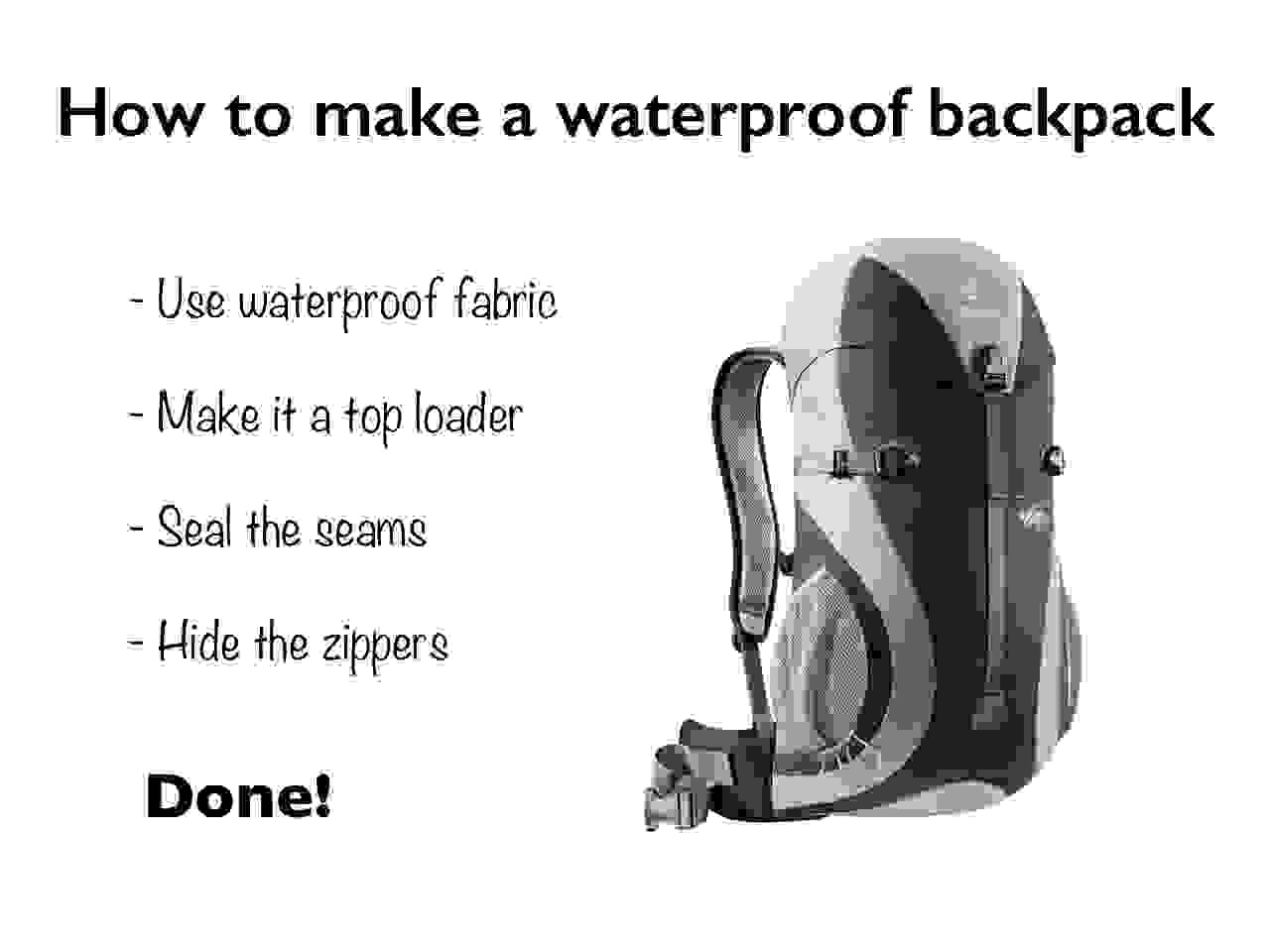
It’s really just that simple.
The specific pack pictured above is the Deuter DS20, which no longer exists. Don’t worry, it wasn’t particularly comfortable anyway. But it did a number of things correctly that made me realize just how stupid the world is for not doing this more often.
Waterproof backpack concerns
These are the standard questions whenever I inform people that non-waterproof top-loading backpacks are stupid:
- Aren’t they expensive? No. See that pack pictured above? It cost a mere $130, and I got it for about $80. Although it’s true that waterproof construction is more expensive to manufacture, this is generally offset by the fact that companies will simply reduce the number of seams to a bare minimum, which is what they should have been doing anyway. Half the seams on most packs are useless, and serve no other function than a fashion statement, and you can cut down on costs by skipping them. And the fabric itself isn’t prohibitively expensive either. Plus you don’t need to buy a rain cover or a dry bag, which means even if it is more expensive, it might not matter.
- Are they more fragile? No. In the case of the pack shown above, the waterproof membrane was actually between two nylon layers, thus creating an exquisitely durable, but also rather normal-looking, waterproof backpack. It was actually tougher than most regular backpacks I’ve used, as it simply featured a better exterior fabric.
“But…but…there must be something!!!!!”
No. Have you ever been in a hiking or camping store and looked at the massive ocean of waterproof jackets available for maybe $100 each? Well, they could just make a pack out of it. Except it would be even cheaper, since those jackets are waterproof and breathable, whereas a pack only needs to be waterproof.
So where are they!?!?!?
I’ve always wondered if the problem was just an up-sell thing; backpacks are absurdly labor-intensive products, yet they might only cost $200, even for a big one. So what’s a good way to increase profit margins on a low-margin product? Up-sell a customer with a high-margin add-on, like a rain cover. They’re just a garbage bag with an elastic band, but they might cost up to $40. That would be hugely profitable.
But then these companies sell backpacks with included rain covers, often at the same price of those that don’t, so I can only imagine that it’s just out of sheer stupidity.
Okay, I know I’m being a little mean, but again, why the hell not? Most outdoor backpacks are top-loaders (which is annoying, but oh well), meaning all they’d need is a waterproof fabric. They wouldn’t even need the welded seams. But quite a few companies use welded seams anyway, but somehow forgo them completely when it comes to backpacks. Come on, guys! Get it together!
Waterproof backpacks that actually exist!
Okay, so a few examples do exist, but it’s astonishingly challenging to track them down. The vast majority of these are small, roll-top backpacks intended for bikers, or maybe kayakers and so on. Some are the type you can actually submerge, though this is less important for hiking, so I won’t go into detail about which is which. Just don’t jump in a lake.
And, in case it’s somewhat ambiguous, this list is not meant as an endorsement; some of these may not work for hiking or traveling, but part of the reason I’m including them is to highlight the rarity of a suitable waterproof hiking backpack to begin with. So this list is by no means comprehensive, nor is it intended as a collection of perfect solutions; just potential options:
Arcteryx Arrakis Pack
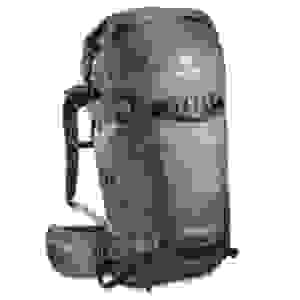
This is one of the extraordinarily few waterproof hiking packs anywhere to be found. It has many of the features that a standard hiking backpack would include, particularly the seriously padded and adjustable straps, which are practically nonexistent in others.
On the downside, it puts a “waterproof” zipper right on top of the bag, which is the stupidest place in the world to put a zipper of any sort. The rain hits right at the top at the highest possible velocity, and “waterproof zippers” seem to be about as imaginary as a unicorn.
But aside from that, it might actually be the only real option you’re able to find. It’s probably going to be a whole lot more comfortable than most other waterproof backpacks, and it has fairly good features as well.
Sadly, it costs $500. But you can get it here.
Sea to Summit Flow 35L DryPack

This one’s another semi-real hiking pack with decent features, including exterior organization, which, for some reason, is exceedingly rare in these types of packs, and I can’t understand why.
On the downside, I think Sea to Summit could have done a little better with this one. See the dark grey thing on the side? That’s a side pocket. And it looks laughably incapable of securely holding a large water bottle. Seriously, what is it with these outdoor companies and their hydrophobia? Where else does a water bottle go?!?!?!
Plus they’ve got loops to attach a bungee cord, but…no bungee cord. Um…okay? Plus they’ve got an exterior zippered pocket, but…I don’t think the zipper is even water-resistant. I could be wrong about this, but it looks normal, and they don’t claim otherwise. I can’t sigh hard enough to convey my annoyance.
And it’s so…bulbous. Is there really any reason for a pack this size to jut away from your torso this much? I mean, I know the compression straps are there to fix the problem, but why include the problem to begin with?
On the upside, it’s got some serious shoulder and hip straps. It’ll work well. Except for all those weird problems.
Get it here.
SealLine Urban Backpack
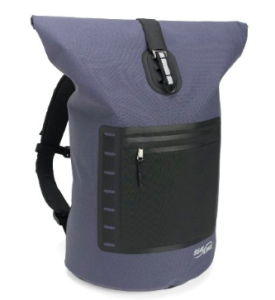
And just like that, we’re already moving away from “you could use this for hiking” and into “this is basically all there is.”
This is the standard format for most waterproof backpacks: Roll-top closure, with minimal exterior adornments. It works, but it limits how conveniently you’re able to find specific items. But if you’ve been using top-loading backpacks this whole time anyway (and most people do, since those are often the only option), then this isn’t much different.
It comes in quite a few colors, and multiple sizes. The larger of the two is right around the ideal size for traveling or longer hikes, though again, the lack of exterior features can be limiting. The back is quite nicely padded, though.
You can get it here.
Ortlieb Velocity Backpack
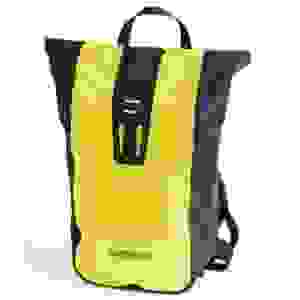
Once again, a roll-top backpack with minimal exterior features, mainly designed for bikers. But it’ll work.
This is smaller than the others, sized to be a daily commuter pack, which would work fairly well as a daypack for hiking or similar activities.
It has no exterior pockets, but includes a couple attachment points for those who like to strap things to the outside.
It’s probably more suitable for everyday use, for students, or short hikes and other sorts of things, rather than something that could pass for a “hiking pack,” which would probably require something bigger, and with more features.
Get it here.
Timbuk2 Especial Vuelo Backpack
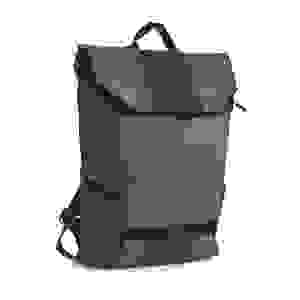
This one’s pretty cool. Built by the cycling-focused Timbuk2, and featuring a flap closure and a roll-top closure, in case you want even more protection, this is a good pack for cycling, and it can be used quite easily for day hikes or random everyday gear hauling as well.
I also think it looks quite nice for city use, rather than resembling a hiking pack or a kayak roll-top dry pack.
Features include two exterior side pockets, a zippered pocket, an internal organizational panel, and a laptop sleeve. The side pockets look a little too small for really big water bottles, but if the main chamber is under-filled, it’ll probably be just fine. There’s a removable sternum strap and waist strap, and its 25 liter capacity isn’t bad for day hikes or city jaunts.
Get it here.
Caveats!
I wish I had a few more decent recommendations, but options are few and far between. This is especially true for hiking packs, which is why I fell so quickly into discussion of related items, many of which tend to be somewhat similar to each other, which is why I didn’t want to spend too much time on them.
I can only conclude that backpack manufacturers are just plain lazy, or that hikers just don’t bother hiking in the rain often enough to complain about this. Though again, it’s really just top-loaders that could do this, and I think exclusive top-loaders are dumb. But most hiking backpacks are top-loaders, which means not making them waterproof is dumb.
I find this especially annoying in the case of companies that did make waterproof backpacks (Deuter, Vaude), but don’t seem to bother anymore, or companies that currently do (Arcteryx), but only one or two that cost $500, or companies that make millions of waterproof jackets but not waterproof backpacks. Sigh.
Maybe someday. But in the meantime…try to make do with a rain cover. Things could be worse.




take a look at the:
patagonia black hole backpack
sea to summit: carve 24L, flow 35L or rapid 26L
cheers!
The Sea to Summit packs work, though I wish they’d make those side pockets more useful. The Patagonia Black Hole backpack is only resistant, although it’s VERY water resistant, but it has just a regular zipper right on the top of the pack that’s just…argh. Such an oversight.
Well… A top loading zipper might annoy you re *rain* but makes perfect sense for *snow*. If the bag is designed for back-country skiers (as is often the case with Arcteryx), then when you set it in the snow, you want the bottom and sides to be dry, and the top to open up. Thanks for listening.
That’s a good point.
Check out the DryCASE waterproof backpacks!
Looks pretty good. One of the few with nice exterior pockets, too.
Thank you for the DRYcase recommendation. I liked it so much I ordered one today!
Sigh. I feel like I’ll never find the perfect pack. I’m even cool with having a buttload of different backpacks (I already do.) But they all seem to have SOMETHING wrong with them. I’m shocked a better waterproof hiking pack doesn’t exist.
Yeah, I get picky too, and I know that occasionally I’m thinking of MY needs rather than others, but I also know a good objective improvement when I see one, dammit!
Have you had a look at One Planet? Small Australian company, ultra high quality and amazing customer service.
Not yet, but I’ll take a look.
Wilderness Equipment make a range of canvas day bags in the 33L to 43L size range. All the openings and zips are protected from the weather. I have 4 of their bags (you can’t have too many day bags) and find them to be really good. Wilderness have a website under wildequipment.
It’s a tough space, backpacks – lots of tradeoffs. For my money (and travels) I like a water resistant backpack (with a cover) rather than waterproof. They tend to be lighter material.
And I like a million zippers, not a top loader, because I like to have easy access to my stuff.
After many trips with a Kelty that I loved (and got stolen) I recently bought a Osprey Radial 34. They have a back airflow system that really works, plus cool little inventions like a whistle built into the chest strap and a clever bike helmet holder.
To each her own…
It’s definitely a trade-off, and it would only really work for a top-loader, and top-loaders are kind of annoying anyway. I much prefer lots of organizational pockets and huge panel openings, but if they’re making all these top-loaders anyway…might as well go waterproof on those.
I would agree with that. Weight aside, why not make top loaders waterproof?
It would be interesting to see what’s heavier – waterproof fabric/zippers or a cover. Might be close…
Saw this and thought you you! It’s only 30liters but… :)
http://cabinmax.com/en/leisure/45-waterproof-rucksack-0616983191927.html
Well, it’s something. Which is more than can be said of most options.
What about the BMG Outdry 105 for $360? It looks like it would be perfect for a hike in some rainy weather.
Hmm, not bad. Gigantic, but I guess that’s what some people need.
They make a 70lversion called the south col as well.
Heh, awesome blog. I’ve got the old Vaude aracanda 30, which has served me fine, even with tiny hip pads and being a top loader =) been travelling tiny for a while now, and now getting into camping. Merp. Will see how that goes. ;)
Yeah, they had a couple packs that worked, and they stopped making them. Lucky you.
Here’s another; The Rainwalker, from thewaterproofstore.com
I don’t understand this scarcity either though some great waterproof packs are made by
One Planet- traditional high capacity canvas packs, waterproof without a liner, beautiful & simple harnesses.
Aarn- UL to lightweight packs, made waterproof by the addition of a liner that velcroes to the mouth of the pack.
My ideal pack would be a waterproof synthetic roll top with a One Planet harness…sigh
Most other packs I have felt the need to use a gardening garbage bag as a liner (Berghaus, WE, Snowgum, Lowe Alpine). This is ok and you can put your pack in the garbage bag if you need to swim rivers or lakes. Of course there is no reason why we shouldn’t be able to have a waterproof packs and carry garbage bag if we like…..carrying a giant plastic bag also seem so acutely out of touch with nature….
Here’s the Aqua Quest Sport 25. It’s the only non-gigantic waterproof pack I found with outside pockets (1 front, 2 waist) and water bottle holders. Most of the other smaller packs are subpar. Mine should arrive in a few days.
http://www.amazon.com/Aqua-Quest-Sport-Waterproof-Backpack/dp/B004Z5XO04/ref=sr_1_2?s=sporting-goods&ie=UTF8&qid=1400034268&sr=1-2&keywords=aqua+quest+25